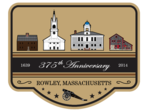Bradstreet Farm
Buildings and structures on the National Register of Historic Places in MassachusettsFarms in MassachusettsUse mdy dates from August 2023
Bradstreet Farm in Rowley, Mass. is believed to be the second-oldest continually operating farm in the U.S. Originally deeded by King Charles I of England to Humphrey Bradstreet in 1635, the property remained in the Bradstreet Family for many generations until 2007, when the Town of Rowley purchased the 120-acre parcel including a 19th century farmhouse and 18th century barn. The Town set aside 103 acres as conservation land, and sold seven acres including the farmhouse and barn as a private residence with historic preservation restrictions. The property is listed on the National Register of Historic Places.
Excerpt from the Wikipedia article Bradstreet Farm (License: CC BY-SA 3.0, Authors).Bradstreet Farm
Hammond Street,
Geographical coordinates (GPS) Address External links Nearby Places Show on map
Geographical coordinates (GPS)
| Latitude | Longitude |
|---|---|
| N 42.716906 ° | E -70.86483 ° |
Address
Bradstreet Farm
Hammond Street
01969
Massachusetts, United States
Open on Google Maps










